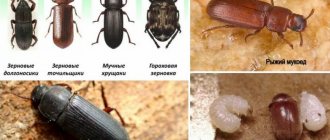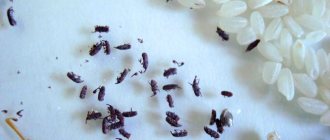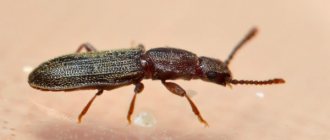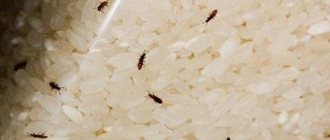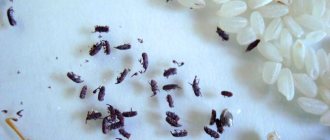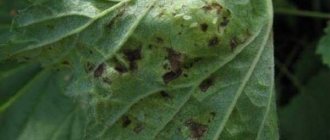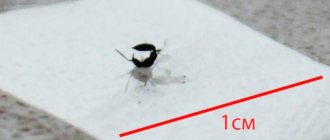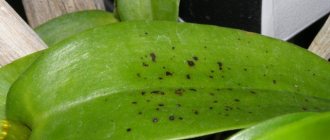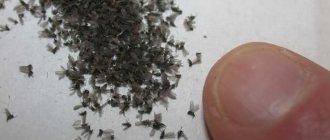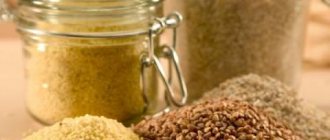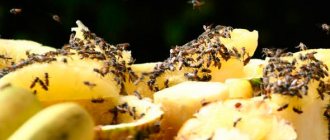The world is literally swarming with insects. And only some of them are capable of arousing our sympathy. For the most part, the reaction is completely opposite. And, of course, no one will be happy with the insects that appear from nowhere in our kitchen, and even in flour or cereal.
Unfortunately, this happens quite often and, as a rule, has nothing to do with the cleanliness or uncleanliness of the hostess.
Causes of insects
Facts indicate that insects in cereals mainly appear due to non-compliance with sanitary requirements at the manufacturing enterprise. This may be due to the lack of heat treatment of the product or its improper storage.
Another reason for the appearance of parasites may be non-compliance with the rules for placing food on kitchen shelves. Flour pests and midges in cereals can get into products from dried fruits, pasta and even hot spices stored nearby, bought in bulk and already infested with some kind of butterfly or midge.
By the way, vacuum packaging does not at all guarantee the purity of the product. The pest could have settled in the cereal or flour long before it was packaged in such a hermetically sealed manner.
In rice
Video
Found an error in the text? Select it, press Ctrl + Enter and we will fix everything!
It's nice to be and work in a clean kitchen. But even in apparent sterility, annoying insects can appear. It is impossible not to notice the midges scurrying everywhere, brazenly climbing and drowning in liquid food products. Every housewife has encountered these problems, but not everyone knows how to remove midges from the kitchen.
In this article we will look at the main places where insects appear in the house, the characteristics of midge varieties, chemical and folk methods of getting rid of them, and a master class on making fly traps.
What insects live in cereals?
Most often, the Suriname flour beetle, bread borer, flour beetle, food moth and weevil are found in flour and cereals. Each of these pests has its own distinctive characteristics and even sometimes an interesting life story.
- The Suriname mucoed arrived to Europe in the 18th century on colonial ships from Holland. Suriname is the name of a small state in South America, a former colony of the Netherlands. The bug is very small, up to 3 mm in length, brown in color. The pest loves not only flour, pasta and grain, but also dried fruits.
- The bread borer is a flying type of insect that can enter a home through an open window or door. It easily penetrates packages of food, cereals, medicinal herbs, tea, coffee and animal feed by chewing through packaging paper. The pest is very tenacious, it can go for a long time without food, and on occasion it likes to eat for future use, in reserve.
- The flour beetle is another lover of flour, millet, semolina, and oatmeal. buckwheat, rice and dried fruits. It has a red-brown color and reproduces well in food, kitchen furniture and even dishes.
- The food moth is a fairly large butterfly, up to 1 cm in length. Very prolific - up to 500 eggs in two weeks. Lives in cereals, grains and flour, which the hatched caterpillars feed on. Coping with this flying parasite can be quite difficult due to its record reproduction rate.
- Weevils , represented by many varieties (barn weevil, nut weevil, rice weevil, oak weevil, etc.), destroyed food supplies even among the inhabitants of Ancient Egypt. This little bug with the elongated nose that gives it its name is truly omnivorous. Almost all varieties are very prolific and are capable of infecting huge food supplies in a short time.
Bread grinder
How to remove midges from an apartment
Insects will never appear where there is nothing to eat. There is a huge risk of acquiring flying “neighbors” near an apartment with small children: scattered candy, spilled juice, crumbs - all these are wonderful living conditions for dipterans. You will have to monitor the child’s actions and clean up after him in a timely manner. A prerequisite for cleanliness is wet cleaning. Sterilizing surfaces with hot steam will help kill fly larvae that are not visible to the naked eye.
Ways to fight
Let us dwell on pest control measures in a specific kitchen.
How to get rid of insects in cereals in the kitchen yourself?
When the slightest sign of the presence of insects in food supplies appears, it is necessary to quickly decide how to get rid of midges and bugs that have encroached on the family’s strategic reserve.
You can deal with insects in cereals yourself in different ways. The first step is to identify the breeding ground for insects by carefully reviewing all supplies of cereals, flour, pasta, dried fruits and even tea and coffee.
Attention! All insect-damaged supplies should be carefully packaged and thrown into the trash.
Kitchen cabinets and household appliances must be washed with detergent and wiped with a cloth soaked in a vinegar solution (1 tablespoon per liter of water). Storage containers should be washed thoroughly with soda solution. Undamaged cereals and flour should be packed in airtight glass containers. If after 10-14 days no insects appear in them, the products are suitable for consumption.
Dried leaves and herbs with a bright aroma (bay leaf, lavender, wormwood, chamomile), as well as borax, vinegar and nutmeg, garlic and citrus fruits, are well suited for pest control. They are laid out on cabinet shelves and periodically replaced with new ones.
Traps that are easy to make yourself will also help against insects. A mixture of borax, powdered sugar and fine cereals in equal proportions is laid out on small lids near the pest habitats.
Sagebrush
Chemical methods and store-bought products
When choosing to get rid of pests using chemicals, you must remember that all of them pose a danger to humans due to their high toxicity. They must be used very carefully, strictly following the attached instructions.
- Pyrethrum powder, which can be purchased at any pharmacy, helps get rid of midges and bugs in the kitchen . The big advantage of this product is that it is safe for human health, but for insects it is a real poison. Treatment with Pyrethrum as a preventive measure should be repeated after a week.
- An effective chemical that can actively resist pests of cereals and flour is the drug Antizhuk . It copes well with insects that have settled in food supplies. The product is used primarily to treat the smooth surfaces of shelves and cabinets, as well as other places where parasites may appear.
- Another good chemical is Lovin Fire Protection . The drug is toxic, so you must remember to take personal safety measures and the safety of children and pets living in the apartment.
- Rogneda chemical allows you to get rid of not only parasites living in cereals, but also cockroaches and ants if they have also appeared in the house.
- The well-known Dichlorvos , as well as other aerosols available on the shelves of specialized stores, copes well with the task of exterminating pests.
Dichlorvos
How to get rid of fruit (fruit) midges
Step 1. Find and eliminate the source of midges
To get rid of eggs, you need to find a source of breeding and food for flies, and then close it in a bag and immediately take it out of the house. As you know, fruit flies lay eggs in fruits and vegetables, but not only that! Any place where there is food and moisture can attract insects. In general, if you can’t find the source, look for it in non-obvious places. Here are some search tips:
- If you keep compost for indoor plants in your kitchen, then you should take a closer look at it.
- When was the last time you cleaned out a trash can? Even if you throw away your trash bag regularly, the container itself can be a source of problems.
- Vinegar, beer and wine also attract insects. Think, maybe there’s an open bottle with a smelly liquid lying around somewhere?
- Mushrooms, cereals and cheeses are far from being fruits or vegetables, but even the midges do not disdain them.
- A clogged kitchen sink is another potential breeding ground for insects.
- Look for any wet sponges, rags or mops that have been left behind.
- Sometimes the cause of midges can be a sweet liquid that has flowed into the base of the headset, kitchen drawer, under the refrigerator or other places.
Step 2. Hide and cover all products
Now you should hide all the food in the kitchen to deprive fruit flies of food and breeding places.
Hide fruits, vegetables, jam, sweets and other midge delicacies in the refrigerator or close them in tightly sealed containers. Do not leave ripe fruit outside the refrigerator until the problem is resolved.
Theoretically, this measure may be enough to kill the midges, but this process will take from 10 days (in the warm season) and up to 2.5 months in winter. Therefore, to get rid of midges in the kitchen quickly, you need to set traps.
Step 3. Set up traps
Traps with funnels and baits are a simple folk method that works 100%. The principle of operation is simple - flies are lured into a container with a small hole by the smell of bait, and cannot fly back out. If you leave such a trap in the kitchen in the evening, in the morning you will find a whole swarm of insects inside it.
How to make a trap:
- Take a glass jar, vase or any other container with high walls and place/pour bait into its bottom, for example:
- Berries or a slice of fruit, say a pear or banana.
- A couple of spoons of jam.
- A little apple cider vinegar.
- Roll an A4 sheet or any other paper into a cone, secure the tip with tape and cut it if necessary, then insert the resulting funnel into the jar. By the way, the most effective trap will be made from yellow or orange paper, which will seem like citrus to midges - the safest treat from their enemies, wasps.
- Place one or a couple of these traps in high-risk areas - for example, near a sink, trash can, flower pot, if there are fruit flies there.
- After a few hours, pour warm soapy water into the jar (without removing the funnel!) to drown the caught insects. Keep the solution in the jar for a couple of minutes and then pour out the contents.
- If you cannot catch all the fruit flies at once, repeat the procedure until the trap is empty. In addition, we recommend repeating the procedure 8-10 days after a positive result, because a “new generation” of midges can grow from the eggs remaining somewhere.
The photo below shows other types of traps with the same principle of operation. As you can see, instead of a paper funnel, you can use a kitchen funnel or cling film perforated with a toothpick (a plastic bag will also work).
By the way, both the jar and the funnel can be made from a plastic bottle. To do this, you need to cut it into two parts, so that the part with the neck is shorter, then insert the resulting funnel into the jar with the neck down and, for reliability, fasten the trap with tape as shown in the photo below.
And a little about prevention
Take note of the following tips to prevent the recurrence of fruit gnats in the kitchen:
- Keep your foods covered, or better yet, in the refrigerator.
- Try to throw out the trash every day, especially if you throw out seeds or pieces of fruit or vegetables. Also, do not forget to wash the trash can itself once a week, and in the summer even 2 times a week.
- Get rid of other potential breeding grounds for fruit flies in a timely manner. Old sponges, rags, wet mops and any other items you use for cleaning may contain midge eggs. Throw them away or wash them in the washing machine on a hot cycle.
- Clean your sink drain regularly.
Is it possible to eat contaminated cereals and flour?
Cereals or flour infested with pests should definitely be thrown away, even if it is a great pity to waste money from a carefully calculated family budget. The fact is that we are talking about the health of the whole family.
Infected cereals contain a variety of insect waste products: the remains of chitinous shells, excrement, etc. Thanks to the worms, bacteria and fungi settle in the cereals, which find here a very favorable habitat and development. All this can cause poisoning and other serious health problems in a person: fever, disruption of intestinal function, and the development of allergic reactions.
Moreover, damage to the body may not appear immediately. The process develops gradually and secretly. Amino acid metabolism is disrupted, the number of red blood cells and hemoglobin in the blood decreases. This leads to weakness, loss of strength, and sometimes more serious consequences. No amount of savings is worth it!
How to store cereals for a long time to prevent insects from infesting them?
Before asking yourself the question of how to properly store cereals and flour, you need to clearly decide how to purchase all this correctly. After all, most often pests enter the kitchen with products purchased at the store.
So you need to approach the choice of buckwheat, rice or oatmeal on store shelves very responsibly. Date of manufacture, appearance of the product, smell, presence of foreign impurities - all this may indirectly indicate the presence of pests in cereals or flour.
And finally, recommendations on what to do to protect yourself from insects in purchased cereals and flour:
- All supplies should be stored in jars, preferably made of transparent glass, with tight-fitting lids. If suddenly insects appear in one of these jars, you need to carefully check all other supplies, and then thoroughly, with laundry soap or soda, wash all kitchen cabinets.
- It is also recommended to treat hard-to-reach places where pests can settle with Dichlorvos or another insecticide.
Is midge dangerous for humans and how does it enter the kitchen?
Drosophila flies, vinegar flies and wine flies, which is what small black midges are called, in the kitchen harm your prestige and disturb peace of mind. They are not dangerous to human life and health. These annoying creatures are found almost everywhere, with the exception of regions with a harsh cold climate. If you look at this little thing under a magnifying glass, you will find that it looks like an ordinary fly.
These creatures prefer to live in a group, so the midge swarms over food that is attractive to it
Where do these insects come from in the apartment? It seems that the doors and windows are closed, the windows are protected by a fine mesh, and the midge is there, flying like a cloud over your flowers or trash can. There are main sources of insects entering your apartment:
- box with vegetables and fruits. As soon as some fruit becomes slightly spoiled, it becomes a tasty bait for midges. If eggs were laid on an apple or grape in a store, the insects will appear in a matter of hours, even the temperature of the vegetable drawer in the refrigerator will not stop them;
- The trash can is the most favorite place for these creatures. Spoiled foods are ideal soil for reproduction and nutrition;
- sink drain - food waste accumulates in the glass or sump. You may not see them, but know: the midge finds this dirt and uses it to feed and reproduce;
- ventilation systems with exits to neighbors. Rarely does anyone protect the internal exits to the ventilation ducts with a fine mesh, so it is not difficult for insects to move to you from less clean neighbors;
- indoor plants - midge eggs are often found in the soil and wait for favorable conditions for them: heat and humidity.
You may accidentally buy contaminated soil or bring a flower from the store that is infected with Drosophila.
